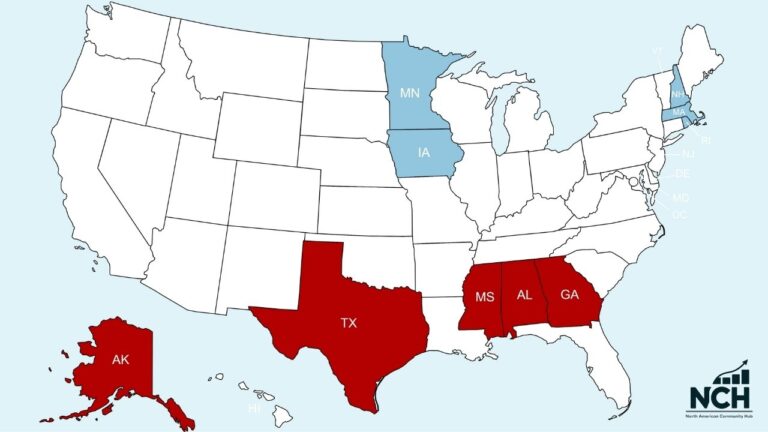The cost of healthcare in the United States remains among the most expensive worldwide, and residents continue to face significant financial strain when paying for care.
Where someone lives plays a critical role in determining how much money leaves their pocket each year for insurance premiums, deductibles, co-pays, and non-covered services.
In 2025, numerous outlets provided comprehensive state rankings, offering insight into how costs vary across the country.
Looking at these numbers, it becomes clear that geography can either ease or intensify financial pressures tied to health.
US States With the Most Affordable Healthcare
Healthcare costs can feel overwhelming, yet several states have structured systems that reduce the financial pressure on families.
States with lower premiums, higher coverage rates, and stronger healthcare infrastructure show that affordability and quality can coexist.
Below are five states leading in out-of-pocket cost relief.

1. Rhode Island
Rhode Island ranks first for affordability, keeping healthcare spending manageable while still offering reliable care.
Strong insurance coverage and excellent outcomes make it a model for efficiency. Residents benefit in multiple ways, including:
- Only 5.6% of income is spent on healthcare
- 94% of adults and 97% of children are insured
- High outcomes and access ratings
- Robust infrastructure of hospitals and clinics
2. New Hampshire
New Hampshire combines affordability with accessibility, easing pressure on households through lower premiums and strong infrastructure.
Affordable urgent care access plays a critical role in keeping costs down.
Key advantages include:
- Average monthly premiums are around $470
- Fourth-lowest out-of-pocket spending nationwide
- Wide availability of urgent care centers
- Continued state investment in public health
3. Minnesota
Minnesota’s healthcare system earns recognition for balance.
Spending and premiums remain manageable, while strong preventive care measures reduce future costs.
Residents experience:
- 13th-lowest average medical spending
- Eighth-lowest premiums in the country
- Expansive public hospital system
- Long life expectancy supported by preventive programs

4. Iowa
Iowa consistently ranks high for affordability, with cost management strategies benefiting both urban and rural residents.
Public policy initiatives and investments in local clinics strengthen the state’s position.
Highlights include:
- First place in WalletHub’s “Cost” category
- Affordable premiums and accessible services
- Strong network of community clinics
- Support for rural populations
5. Massachusetts
Massachusetts proves that higher costs do not always equate to poor value. While residents face above-average expenses, quality and accessibility compensate significantly. Strengths include:
- Ranked 33rd in cost yet high in value due to outcomes
- Nearly universal insurance coverage
- Progressive healthcare programs
- Strong patient outcomes tied to preventive initiatives[/su_note]
US States With the Most Expensive Healthcare
Healthcare costs can also weigh heavily on families when systems lack affordability and efficiency.
Certain states struggle with high premiums, poor access, and limited infrastructure, creating a significant financial burden.
1. Alaska
Alaska consistently struggles with accessibility and affordability due to its geographic challenges.
Residents face higher expenses largely because of distance and limited options.
Key concerns include:
- Highest premiums in the country
- Severe provider shortages
- Geographic isolation limits access
- Strained healthcare infrastructure

2. Mississippi
Mississippi households shoulder one of the heaviest burdens nationwide, spending a disproportionate share of income on healthcare.
Contributing factors include:
- Nearly 18.7% of income is spent on medical care
- Last in national rankings for outcomes
- 41st in access nationwide
- High prevalence of medical debt
3. Alabama
Alabama shows how limited access and poor cost efficiency drive up healthcare costs for residents. Issues extend across both coverage and quality of care.
Problems include:
- Weak performance in cost-efficiency rankings
- Poor health outcomes despite high spending
- Inconsistent access to quality healthcare
- Growing medical debt for households
4. Georgia
Georgia struggles with both affordability and access, especially in rural communities where medical facilities are limited.
Key issues include:
- High healthcare costs relative to outcomes
- Limited insurance coverage in rural areas
- Inconsistent provider availability
- Growing frustration among residents

5. Texas
Texas continues to rank poorly in terms of affordability and access, making it one of the hardest states for families to manage healthcare costs.
Contributing factors include:
- Fourth-highest costs in the nation
- Lowest national ranking for access
- Large uninsured population
- Limited Medicaid expansion
Policy Implications and Solutions

Efforts are underway at both the state and federal levels to address these challenges.
States seek to reduce premiums, expand Medicaid, and strengthen primary care networks.
Federal policies aim to expand Health Savings Accounts and cap out-of-pocket spending.
Potential solutions include:
- Expanding Medicaid coverage to reach more households
- Increasing urgent care center availability
- Investing in preventive and primary care services
- Setting limits on out-of-pocket expenses nationwide
In addition to systemic reforms, financial empowerment options such as those offered by CreditNinja in the personal finance sector demonstrate the value of flexible, transparent, and supportive solutions for families under stress..
Closing Thoughts
Location can make a world of difference in how much money residents must dedicate to medical care.
Some states have created supportive systems that ease the burden, while others continue to see households struggling under the weight of medical debt.
Despite progress in certain regions, inequities remain pronounced.
A nationwide push for transparency, affordability, and equity will be key to ensuring that healthcare works for every American family.

